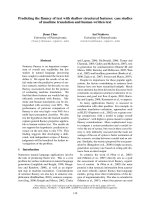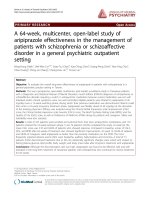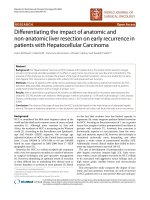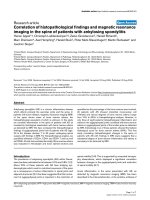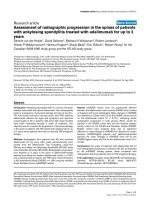Optimal staging system for predicting the prognosis of patients with hepatocellular carcinoma in China: A retrospective study
Bạn đang xem bản rút gọn của tài liệu. Xem và tải ngay bản đầy đủ của tài liệu tại đây (1.01 MB, 9 trang )
Su et al. BMC Cancer (2016) 16:424
DOI 10.1186/s12885-016-2420-0
RESEARCH ARTICLE
Open Access
Optimal staging system for predicting the
prognosis of patients with hepatocellular
carcinoma in China: a retrospective study
Lihui Su1†, Tao Zhou1†, Zongli Zhang2, Xiuguo Zhang2, Xuting Zhi2, Caixia Li3, Qingliang Wang3, Chongqi Jia4,
Wenna Shi1, Yanqiu Yue1, Yanjing Gao1* and Baoquan Cheng1*
Abstract
Background: Several staging systems have been developed to evaluate patients with hepatocellular carcinoma
(HCC), including the China Staging System (CS), the American Joint Committee on Cancer (AJCC) tumor-node-metastasis
(TNM) staging system, and seventh edition; the Barcelona Clinic Liver Cancer (BCLC) staging system, and Cancer of the
Liver Italian Program (CLIP) staging system. The optimal staging system for to evaluate patients in China with HCC has not
been determined. This study was designed to determine the optimal staging system for predicting patient prognosis by
comparing the performances of these four staging systems in a cohort of Chinese patients with HCC.
Methods: This study enrolled 307 consecutive Chinese patients with HCC in Shandong Province. The performances of
the CS, TNM, BCLC, and CLIP staging systems were compared and ranked using a concordance index. Predictors of
survival were identified using univariate and multivariate Cox model analyses.
Results: The mean overall survival of the patient cohort was 12.08 ± 11.87 months. Independent predictors of survival
included tumor size, number of lesions, tumor thromboses, cirrhosis, serum albumin level and serum total bilirubin level.
Compared with the other three staging systems, the CS staging system showed optimal performance as an independent
predictor of patient survival. The BCLC staging system showed the poorest performance; its treatment algorithm was not
suitable for patients in this study.
Conclusions: CS was the most suitable staging system for predicting survival of patients with HCC in China.
Keywords: Hepatocellular carcinoma, Prognosis, Staging system, Independent predictors, Overall survival
Background
Hepatocellular carcinoma (HCC) is the sixth most common cancer and the third leading cause of cancer deaths
worldwide [1]. Approximately 55 % of patients with HCC
live in China and the 5-year overall survival (OS) rate is
only 7 % [2]. Unlike other solid tumors, the prognosis and
treatment options for patients with HCC depend not only
on the tumor stage but also on residual liver function [3].
Many staging systems that include both the liver cancer
and residual liver function have been developed, including
the Cancer of the Liver Italian Program (CLIP); the Barcelona Clinic Liver Cancer (BCLC), the American Joint
* Correspondence: ;
†
Equal contributors
1
Department of Gastroenterology, Qilu Hospital, School of Medicine,
Shandong University, Jinan 250012, China
Full list of author information is available at the end of the article
Committee on Cancer (AJCC) tumor-node-metastasis
(TNM), seventh edition and the China Staging (CS) systems [4–8].
Many clinical trials in western countries have evaluated
the staging, natural history and prognosis of patients with
HCC, with highly variable [9, 10]. Despite China having a
greater disease burden than the rest of the world, few studies have been performed in China. Shandong Province,
located in the east of China, has a high incidence of HCC.
To date, the tumor staging system optimal for evaluating
patients with HCC in Shandong province has not been
determined. This retrospective study compared the performances of four staging systems, the CLIP, BCLC, AJCC
TNM 7th edition, and CS staging systems, in patients with
HCC in Shandong Province, China, who were treated at
Qilu Hospital of Shandong University. This study also
© 2016 The Author(s). Open Access This article is distributed under the terms of the Creative Commons Attribution 4.0
International License ( which permits unrestricted use, distribution, and
reproduction in any medium, provided you give appropriate credit to the original author(s) and the source, provide a link to
the Creative Commons license, and indicate if changes were made. The Creative Commons Public Domain Dedication waiver
( applies to the data made available in this article, unless otherwise stated.
Su et al. BMC Cancer (2016) 16:424
attempted to identify factors independently prognostic of
survival in these patients.
Methods
This study was approved by the institutional ethical
committee at Qilu Hospital of Shandong University. All
patients or their family provided written informed consent for their clinical records to be stored in the hospital
database and used for research.
Page 2 of 9
needle biopsy samples (especially if mass less than 2 cm).
Alternatively, a diagnosis of HCC was based on the radiologic criteria of the European Association for the Study of
the Liver (EASL) [11, 12]. Based on collected data, all included patients were restaged retrospectively according to
the CLIP, BCLC, AJCC TNM seventh edition, and CS staging systems.
Statistical methods
Patients
Between January 1, 2010, and October 31, 2014, 673 consecutive patients diagnosed with liver cancer were seen at
Qilu Hospital of Shandong University. Of these, 366 patients were excluded, including 152 lost to follow-up, 88
with missing data, 58 with cancer of other organs or tissues metastasis to the liver, 47 diagnosed with intrahepatic
cholangiocellular carcinoma, and 21 diagnosed at other
centers and referred to Qilu Hospital. The remaining 307
patients with HCC were consecutively enrolled and retrospectively analyzed (Fig. 1).
Baseline information, including the results of clinical examinations, laboratory evaluations, imaging modalities (e.g.
computed tomography [CT], magnetic resonance imaging
[MRI] and/or ultrasonography), was collected at the time of
diagnosis. OS was defined the time from the date of initial
diagnosis of HCC to the date of death, last follow-up or the
date of censoring (January 1, 2015), whichever came first.
HCC diagnosis was confirmed by histopathological
examination of surgical samples or cytologic evaluation of
Fig. 1 Flow chart of the study
All patients were followed up until death or January 1,
2015. Continuous variables were expressed as mean ±
standard deviation (SD), and categorical as frequencies
and percentage. Survival outcomes were estimated by the
Kaplan–Meier method and compared by the log-rank test.
Staging systems were ranked using the concordance
index (c-index), which measures the capacity of the different staging systems to stratify patients with different
outcomes: the higher the c-index, the more informative
the model was about patient outcomes.
Independent prognostic factors were identified through
backward stepwise selection in a Cox regression model.
Variables significant (p < 0.05) on univariate analysis were
included in the multivariate Cox proportional hazards
model. Adjusted hazard ratios (HRs) and 95 % confidence
intervals (95 % CIs) were calculated.
All statistical analyses were performed using STATA/SE
version 13.1 software (Stata Corporation, College Station,
TX, USA). All p-values were two-sided, and those less
than 0.05 were considered statistically significant.
Su et al. BMC Cancer (2016) 16:424
Page 3 of 9
Table 1 Baseline demographic and clinical characteristics of the
307 patients with hepatocellular carcinoma (Additional files 1 and 2)
Characteristic
Age, years
Table 1 Baseline demographic and clinical characteristics of the
307 patients with hepatocellular carcinoma (Additional files 1 and 2)
(Continued)
Laboratory values, mean ± SD
Mean ± SD
55.43 ± 10.69
Total bilirubin (μmol/l)
24.55 ± 50.93
Range
11–84
Albumin (g/l)
38.53 ± 5.78
Prothrombin time (sec)
0.19 ± 0.80
Sex, %
Male
252 (82.1)
Female
55 (17.9)
ECOG PS, %
AFP (ng/ml), %
< 400
211 (68.7)
≥ 400
96 (31.3)
0
100 (32.6)
1
146 (47.6)
Tumor size (mean ± SD, cm)
2
44 (14.3)
Number of lesions, %
3
16 (5.2)
1
4
1 (0.3)
2–3
29 (9.4)
≥4
78 (25.4)
Etiology, %
Tumor characteristics
6.18 ± 4.04
200 (65.2)
HBV
239 (77.8)
HCV
7 (2.3)
Unilobar
164 (53.4)
HBV + HCV
2 (0.7)
≥ bilobar
143 (46.6)
Alcoholism
5 (1.6)
Other
54 (17.6)
Child-Pugh Grade, %
A
239 (77.9)
B
56 (18.2)
C
12 (3.9)
Child-Pugh Score, %
Lobar involvement, %
Tumor morphology, %
Uninodular
147 (47.9)
Multinodular
77 (25.1)
Massive, diffuse
83 (27.0)
Vascular and/or organ invasion, %
No
235 (76.6)
Portal/hepatic vein
52 (16.9)
5
176 (57.4)
Other vascular
9 (2.9)
6
63 (20.5)
Organ invasion
11 (3.6)
7
36 (11.7)
8
9 (2.9)
No
252 (82.1)
9
11 (3.6)
Yes
55 (17.9)
10
9 (2.9)
M, %
11
3 (1.0)
No
278 (90.6)
Yes
29 (9.4)
Hepatic encephalopathy, %
No
307 (100.0)
Yes
0 (0)
Ascites, %
N, %
Tumor thrombosis, %
None
247 (80.4)
Portal stem vein
26 (8.5)
No
219 (71.4)
Inferior vena cava
6 (1.9)
Little
56 (18.2)
Hepatic vein branches
2 (0.7)
Middle
24 (7.8)
Portal vein branches
16 (5.2)
Large
8 (2.6)
Vessel
3 (1.0)
Hepatic duct
2 (0.7)
Inferior vena cava branches and
Portal vein branches and/or
Hepatic vein branches
5 (1.6)
Portal hypertension, %
No
245 (79.8)
Yes
62 (20.2)
Cirrhosis, %
Current outcomes, %
No
97 (31.6)
Yes
210 (68.4)
Dead
120 (39.1)
Alive
187 (60.9)
OS, mean ± SD, months
12.08 ± 11.87
Su et al. BMC Cancer (2016) 16:424
Page 4 of 9
Results
Table 3 Univariate analyses of factors independently prognostic of
overall survival in the 307 patients with hepatocellular carcinoma
Patient characteristics
Of the 307 patients with HCC included in the study, 252
(82.1 %) were male and 55 (17.9 %) were female, with a
mean age of 55.43 ± 10.69 years. Among the 307 patients
with HCC, 143 (46.6 %) were confirmed by histopathological examination of surgical samples or cytologic evaluation of needle biopsy samples, that the main tumor
differentiation was intermediate (40.6 %), and 164 (53.4 %)
were diagnosed by the imaging criteria. The most frequent
etiology of underlying liver disease was hepatitis B virus
(HBV) infection (77.8 %), followed by other etiology
(17.6 %), hepatitis C virus (HCV) infection (2.3 %) and alcoholism (1.6 %); only 0.7 % of patients were infected with
Variable
Coefficient
SE
P
HR
95 % CI
Sex
0.39
0.28
0.156
1.48
0.86–2.54
Age
−0.09
0.08
0.293
0.92
0.78–1.08
ECOG PS
0.74
0.10
0.000
2.10
1.74–2.54
Tumor size
0.15
0.02
0.000
1.16
1.12–1.21
Number of lesions
0.58
0.10
0.000
1.78
1.47–2.17
Lobar involvement
1.16
0.20
0.000
3.20
2.18–4.70
Tumor formation
0.70
0.11
0.000
2.01
1.63–2.49
Ascites
0.44
0.10
0.000
1.55
1.27–1.89
Total bilirubin
0.68
0.14
0.000
1.98
1.51–2.60
Albumin
−0.10
0.02
0.000
0.91
0.88–0.94
Child-Pugh Grade
0.86
0.16
0.000
2.37
1.72–3.25
Table 2 Tumor staging information of the 307 patients with
hepatocellular carcinoma
alpha-fetoprotein
0.72
0.18
0.000
2.05
1.43–2.94
hepatitis B virus
−0.37
0.21
0.081
0.69
0.46–1.05
Staging system
hepatitis C virus
−0.55
0.59
0.347
0.58
0.18–1.82
Patients (%)
CLIP
Alcoholism
0.53
0.59
0.366
1.70
0.54–5.36
0
95 (30.9)
Other
0.42
0.23
0.066
1.53
0.97–2.39
1
86 (28.0)
Lymph node metastasis
0.81
0.21
0.000
2.26
1.48–3.43
2
42 (13.7)
Distant metastasis
1.37
0.22
0.000
3.93
2.56–6.05
3
53 (17.3)
Tumor thromboses
1.31
0.20
0.000
3.71
2.50–5.50
4
21 (6.8)
Portal hypertension
0.30
0.22
0.173
1.35
0.88–2.09
5
8 (2.6)
Cirrhosis
−0.80
0.18
0.000
0.45
0.31–0.64
6
2 (0.7)
Vascular/organ invasion
BCLC
0
10 (3.3)
A
45 (14.7)
B
32 (10.4)
C
196 (63.8)
D
24 (7.8)
TNMa
I
133 (43.3)
II
41 (13.4)
IIIA
15 (4.9)
IIIB
37 (12.0)
IIIC
11 (3.6)
IVA
41 (13.4)
IVB
29 (9.4)
CS
a
Ia
49 (16.0)
Ib
42 (13.7)
IIa
51 (16.6)
IIb
63 (20.5)
IIIa
90 (29.3)
IIIb
12 (3.9)
Seventh edition
Portal/hepatic vein
1.31
0.21
0.000
3.72
2.47–5.60
Others
0.79
0.33
0.015
2.21
1.17–4.18
both HBV and HCV. In total, 65.2 % of patients had a single tumor, with a mean tumor size of 6.18 ± 4.04 cm; and
77.9 % of patients had underlying Child-Pugh class A liver
function. Regarding treatment modalities, 56.1 % of patients underwent curative procedures (LR and RFA),
whereas TACE, MWA, systemic treatment and supportive
care were administrated to 18.9 %, 3.9 %, 4.2 %, 16.9 % of
patients, respectively. Of the 307 patients, 120 (39.1 %)
had died by the time of the final analysis (January 1,
Table 4 Multivariate analysis of factors prognostic of overall
survival in the 307 patients with hepatocellular carcinoma
Variables
Coefficient
Cirrhosis
SE
P
HR
95 % CI
−0.56
0.21
0.008
0.57
0.38–0.87
Tumor size
0.11
0.02
0.000
1.12
1.07–1.17
Number of lesions
0.36
0.11
0.001
1.44
1.16–1.79
Total bilirubin
0.56
0.16
0.000
1.74
1.28–2.37
−0.04
0.02
0.019
0.96
0.93–0.99
0.70
0.22
0.001
2.01
1.31–3.09
Albumin
Tumor thromboses
Su et al. BMC Cancer (2016) 16:424
Page 5 of 9
Fig. 2 Kaplan–Meier analysis of overall survival in 307 patients with hepatocellular carcinoma stratified according to the Cancer of the Liver Italian
Program (CLIP) staging system. All differences between groups wee statistically significant (p < 0.001)
2015). The mean OS was 12.08 ± 11.87 months (Table 1;
Additional files 1 and 2).
Patients were classified into stage groups according to
the four staging systems. According to the BCLC staging
system, 63.8 % of referred patients had advanced stage
tumor stages. In contrast, the different AJCC TNM
stages were more evenly distributed, and 96.7 % of patients had CLIP scores ≤ 4. According to the CS staging
system, 29.7, 37.1, and 33.2 % of patients had stages I, II,
and III disease, respectively (Table 2).
Baseline predictors of survival
Univariate analysis showed that Child-Pugh grade, tumor
size and number, serum total bilirubin and AFP concentrations, tumor thromboses, and cirrhosis were significantly associated with OS (Table 3). Multivariate analysis
found that tumor size, number of lesions; serum total bilirubin level and tumor thromboses were the most accurate
independent predictors of OS (p ≤ 0.001 each). In addition,
cirrhosis and albumin were also predictive of reduced OS
(Table 4).
Fig. 3 Kaplan–Meier analysis of overall survival in 307 patients with hepatocellular carcinoma stratified according to the Barcelona Clinic Liver
Cancer staging system. All differences between groups were statistically significant (p < 0.001)
Su et al. BMC Cancer (2016) 16:424
Page 6 of 9
Fig. 4 Kaplan–Meier analysis of overall survival in 307 patients with hepatocellular carcinoma stratified according to the AJCC TNM seventh
edition staging system. All differences between groups were statistically significant (p < 0.001)
Survival comparisons among staging groups
Survival curves were generated by Kaplan–Meier method
for each of the four staging systems. Stage groupings of all
four staging systems were significantly predictive of OS
(p < 0.001 each), although some overlapping of survival
curves was observed (Figs. 2, 3, 4 and 5).
Ranking of discriminatory ability of staging system
The prognostic ability of the different staging systems was
compared by calculating the c-index of each. The CS
staging system had the highest c-index (0.75; 95 % CI,
0.71–0.80), followed by CLIP (0.74; 95%CI, 0.69–0.79), the
AJCC TNM seventh edition (0.70; 95 % CI, 0.65–0.75),
and BCLC (0.69; 95 % CI, 0.65–0.73) staging systems.
There was a significant difference between prognostic
ability of the CS staging system compared with BCLC
staging system (p = 0.031). However, it was no statistically difference among the others (CS compared with
CLIP, p = 0.130; CS compared with the AJCC TNM seventh edition, p = 0.746; CLIP compared with the AJCC
Fig. 5 Kaplan–Meier analysis of overall survival in 307 patients with hepatocellular carcinoma stratified according to the Chinese staging system.
All differences between groups were statistically significant (p < 0.001)
Su et al. BMC Cancer (2016) 16:424
Page 7 of 9
Table 5 Ranking of staging systems by concordance indices in
patients with hepatocellular carcinoma
Rank
System
C-index
95 % CI
1
CS
0.75
0.71–0.80
2
CLIP
0.74
0.69–0.79
3
TNM
a
0.70
0.65–0.75
4
BCLC
0.69
0.65–0.73
a
Seventh edition
TNM seventh edition, p = 0.243; CLIP compared with
BCLC, p = 0.661; the AJCC TNM seventh edition compared with BCLC, p = 0.080) (Table 5).
Discussion
The predominant etiology of HCC in patients in Shandong
Province China was HBV infection. This study of factors
independently prognostic of OS in this population found
that tumor extent (e.g. tumor size, number of liver lesions,
and tumor thromboses), hepatic function (serum total bilirubin concentration and serum albumin level), cirrhosis
were independent baseline predictors of OS. Of this patient population, 68.4 % had underlying cirrhosis, which
was strongly associated with OS, and 70–80 % showed
histological evidence of liver cirrhosis. AFP was again of
limited use in this study, because it was proven to be both
not sensitive enough to identify early stage HCC and not
specific enough to avoid unnecessary recall procedures, so
AFP test has been dropped from the latest Western guideline for the clinical diagnosis of HCC [11–13]. We also
founded that serum total bilirubin concentration, serum
albumin level and greater tumor extent were related to
poor prognosis variables, indicating that the long-term
survival of patients with HCC was associated not only with
the tumor but with liver function [3, 14–16].
CS was a new staging system proposed by Chinese Society of Liver Cancer (CSLC) for the patients with hepatocellular carcinoma and was initially launched in 2001. The
CS staging system combined hepatic function, as defined
by Child-Pugh classification, and tumor extent, as defined
by adjusted TNM stage, that the parameters included
tumor size and tumor location, thrombosis (portal vein, inferior vena cava and biliary duct), lymph node metastasis,
distant metastasis and the Child-Pugh classification [8]. It
classified stages of disease into six subgroups, from Ia to
IIIb (Table 6). This study found that the CS staging system
had the highest c-index and there was a significant difference between prognostic ability of the CS staging system
compared with BCLC staging system (p = 0.031). So, the
CS staging system was optimal in distinguishing survival
categories in patients with HCC in Shandong Province,
China. The CS staging system was the most prognostic in
our cohort because it included the independent predictors
of survival we had identified. These included serum
concentration of total bilirubin and serum albumin level,
parameters of Child-Pugh grade, which can reflect the residual hepatic function of the patients with HCC; and
tumor stage (tumor size, portal vein thromboses, and
number of liver lesions). In contrast, the BCLC staging system showed the poorest performance, despite its having
been viewed as the standard classification that is used for
trial design and clinical management of patients with HCC
[17]. Several reasons may explain the unsuitability of the
BCLC staging system for Chinese patients with HCC. First,
studies have shown that the performance of the BCLC staging system may be better in patients with early than late
stage disease [18, 19]. However, 63.8 % of the patients in
our study had advanced stage disease (BCLC stage C), limiting the discriminatory ability of BCLC staging. Second,
the natural history of HCC may vary by underlying etiology. The primary cause of HCC in western countries is
HCV infection, whereas the primary cause of HCC in our
population was HBV infection (77.8 %). Therefore, the
ability of BCLC staging to stratify Asian patients with
HBV-associated HCC remains unclear [19, 20].
This study had several potential limitations. First, it
was retrospective in design. Moreover, 152 patients were
lost to follow up and data were missing for 88. However,
Table 6 The classification criteria of China staging system
Stage
Tumor size (cm) and location
Thrombosis
N
M
Child-Pugh score
Ia
single, ≤ 3
absent
absent
absent
A
Ib
unilobar, ≤ 5
absent
absent
absent
A
A
IIa
unilobar, ≤ 10; or bilobar, ≤ 5
absent
absent
absent
IIb
unilobar, >10; or bilobar, > 5; any
absent; portal vein, or inferior
vena cava, or biliary duct branches
absent
absent
absent
absent
A or B
IIIa
any;
portal vein, or inferior vena cava,
or biliary duct stem;
any
any
A or B
any;
any;
present
any
any
any
any
present
any
any
any
any
IIIb
N lymph node metastasis, M distant metastasis
C
Su et al. BMC Cancer (2016) 16:424
many Chinese people live in the countryside, making
communication difficult. Thus, there may have been potential bias in patient selection. Secondly, this was a singlecenter study involving patients admitted consecutively to
Qilu Hospital of Shandong University for treatment. However, our study had several strengths. Complete data were
obtained from a large number of patients. Moreover, the
follow-up period was relatively long, and the epidemiological characteristics of our cohort were consistent with
those reported in other studies of Chinese patients with
HCC [20, 21].
Conclusions
Of the four HCC staging systems evaluated, the CS staging
system was the most informative in predicting survival for
patients with HCC in Shandong Province. The poor performance of the BCLC staging system in this cohort suggests its unsuitability for evaluating Chinese patients with
HCC. We also found that tumor size, number of lesions,
tumor thromboses, serum total bilirubin level; albumin and
cirrhosis were the accurate independent predictors of OS.
Abbreviations
95 % CI, 95 % confidence interval; AFP, alpha-fetoprotein; AJCC, American
Joint Committee on Cancer; BCLC, Barcelona Clinic Liver Cancer; c-index,
concordance index; CLIP, Cancer of the Liver Italian Program; CS, China Staging
System; CSLC, Chinese Society of Liver Cancer; CT, computed tomography;
ECOG PS, Eastern Cooperative Oncology Group performance status; HBV,
hepatitis B virus; HCC, hepatocellular carcinoma; HCV, hepatitis C virus; HR,
hazard ratio; M, Distant metastasis; MRI, magnetic resonance imaging; N, Lymph
node metastasis; OS, overall survival; SD, standard deviation; SE, standard error;
TNM, tumor-node-metastasis
Additional files
Additional file 1: Availability of data and material(1). (XLS 99 kb)
Additional file 2: Availability of data and material(2). (DOC 30 kb)
Acknowledgments
The authors thank the staff of Qilu Hospital of Shandong University for help
with the clinical data. We thank nurses Min Zhang, Aifang Zhu, and Jianrong
Bai for their contributions to care and referral of patients as well as data
acquisition.
Funding
Tackling key problems in science and technology of Shandong province and
the Fundamental Research Funds of Shandong University (Number:
2009GG20002039; 2014QLKY10) supported this research in the design of the
study and collection, analysis, and interpretation of data and in writing the
manuscript.
Availability of data and materials
All datasets on which the conclusions of the manuscript rely to be
presented in additional supporting files in excel table format.
Authors’ contributions
BQC, YJG, TZ and LHS conceived the trial concept and designed the
protocol. LHS acquired data. CQJ is responsible for analysis and
interpretation of data. LHS, BQC, ZT, WNS, and YQY are responsible for
drafting of the manuscript. YJG, TZ, LHS, XGZ, XTZ, ZLZ, CXL, QLW, WNS and
YQY are responsible for clinical work, and administrative and technical
support. BQC is the principle investigator and responsible for trial conduct
Page 8 of 9
and critical revisions of the manuscript. All authors aided in drafting the
manuscript. All authors have read and approved the final manuscript.
Competing interests
The authors declare that they have no competing interests.
Consent for publication
All patients or their family provided written informed consent for their
clinical records to be stored in the hospital database and used for research,
and consent to publish.
Ethics approval and consent to participate
This study was approved by the institutional ethical committee at Qilu
Hospital of Shandong University (Number: 2014042).
Author details
1
Department of Gastroenterology, Qilu Hospital, School of Medicine,
Shandong University, Jinan 250012, China. 2Department of Hepatobiliary
Surgery, Qilu Hospital, School of Medicine, Shandong University, Jinan
250012, China. 3Department of Intervention, Qilu Hospital, School of
Medicine, Shandong University, Jinan 250012, China. 4Department of
Epidemiology and Health Statistics, Shandong University, Jinan 250012,
China.
Received: 14 December 2015 Accepted: 27 June 2016
References
1. Forner A, Llovet JM, Bruix J. Hepatocellular carcinoma. Lancet. 2012;379:
1245–55.
2. El-Serag HB, Mason AC. Rising incidence of hepatocellular carcinoma in the
United States. N Engl J Med. 1999;340:745–50.
3. Abou-Alfa GK. Hepatocellular carcinoma: Molecular biology and therapy.
Semin Oncol. 2006;33:S79–83.
4. A new prognostic system for hepatocellular carcinoma: a retrospective
study of 435 patients: the Cancer of the Liver Italian Program (CLIP)
investigators. Hepatology.1998;28:751-5.
5. Maida M, Orlando E, Cammà C, Cabibbo G. Staging systems of
hepatocellular carcinoma: A review of literature. World J Gastroenterol. 2014;
20:4141–50.
6. Llovet JM, Brú C, Bruix J. Prognosis of hepatocellular carcinoma: the BCLC
staging classification. Semin Liver Dis. 1999;19:329–38.
7. Edge SB, Byrd DR, Compton CC, Fritz AG, Greene FL, Trotti A. AJCC cancer
staging manual. 7th ed. New York: Springer; 2010.
8. Qu Q, Rui JA, Wang SB, Chen SG, Zhou L, Han K, et al. Comparison of
different clinical staging systems for hepatocellular carcinoma. Zhonghua
zhong liu za zhi [Chinese journal of oncology]. 2006;28:155–8.
9. Cho YK, Chung JW, Kim JK, Ahn YS, Kim MY, Park YO, et al. Comparison of 7
staging systems for patients with hepatocellular carcinoma undergoing
transarterial chemoembolization. Cancer. 2008;112:352–61.
10. op den Winkel M, Nagel D, Sappl J, op den Winkel P, Lamerz R, Zech CJ, et
al. Prognosis of patients with hepatocellular carcinoma. Validation and
ranking of established staging-systems in a large western HCC-cohort. PLoS
ONE. 2012;7:e45066.
11. Bruix J, Sherman M, Llovet JM, Beaugrand M, Lencioni R, Burroughs AK, et
al. EASL Panel of Experts on HCC. Clinical management of hepatocellular
carcinoma. Conclusions of the Barcelona-2000 EASL conference. European
Association for the Study of the Liver. J Hepatol. 2001;35:421–30.
12. Bruix J, Sherman M. Management of Hepatocellular Carcinoma. Hepatology.
2005;42:1208–35.
13. Bruix J, Sherman M. Management of hepatocellular carcinoma: an update.
Hepatology. 2011;53:1020–2.
14. Hsu CY, Hsia CY, Huang YH, Su CW, Lin HC, Pai JT, et al. Comparison of
surgical resection and transarterial chemoembolization for hepatocellular
carcinoma beyond the Milan criteria: a propensity score analysis. Ann Surg
Oncol. 2012;19:842–9.
15. Zhou L, Rui JA, Wang SB, Chen SG, Qu Q. Risk factors of poor prognosis and
portal vein tumor thrombosis after curative resection of solitary
hepatocellular carcinoma. Hepatobiliary Pancreat Dis Int. 2013;12:68–73.
Su et al. BMC Cancer (2016) 16:424
Page 9 of 9
16. Huitzil-Melendez FD, Capanu M, O’Reilly EM, Duffy A, Gansukh B, Saltz LL, et
al. Advanced hepatocellular carcinoma: which staging systems best predict
prognosis? J Clin Oncol. 2010;28:2889–95.
17. Llovet JM, Di Bisceglie AM, Bruix J, Kramer BS, Lencioni R, Zhu AX, et
al. Panel of Experts in HCC-Design Clinical Trials. Design and endpoints
of clinical trials in hepatocellular carcinoma. J Natl Cancer Inst. 2008;
100:698–711.
18. Cillo U, Vitale A, Grigoletto F, Farinati F, Brolese A, Zanus G, et al.
Prospective validation of the Barcelona Clinic Liver Cancer staging system.
J Hepatol. 2006;44:723–31.
19. Marrero JA, Fontana RJ, Barrat A, Askari F, Conjeevaram HS, Su GL, et al.
Prognosis of hepatocellular carcinoma: comparison of 7 staging systems in
an American cohort. Hepatology. 2005;41:707–16.
20. Chan SL, Mo FK, Johnson PJ, Liem GS, Chan TC, Poon MC, et al. Prospective
validation of the Chinese University Prognostic Index and comparison with
other staging systems for hepatocellular carcinoma in an Asian population.
J Gastroenterol Hepatol. 2011;26:340–7.
21. Leung TW, Tang AM, Zee B, Lau WY, Lai PB, Leung KL, et al. Construction of
the Chinese University Prognostic Index for hepatocellular carcinoma and
comparison with the TNM staging system, the Okuda staging system, and
the Cancer of the Liver Italian Program staging system: a study based on
926 patients. Cancer. 2002;94:1760–9.
Submit your next manuscript to BioMed Central
and we will help you at every step:
• We accept pre-submission inquiries
• Our selector tool helps you to find the most relevant journal
• We provide round the clock customer support
• Convenient online submission
• Thorough peer review
• Inclusion in PubMed and all major indexing services
• Maximum visibility for your research
Submit your manuscript at
www.biomedcentral.com/submit

